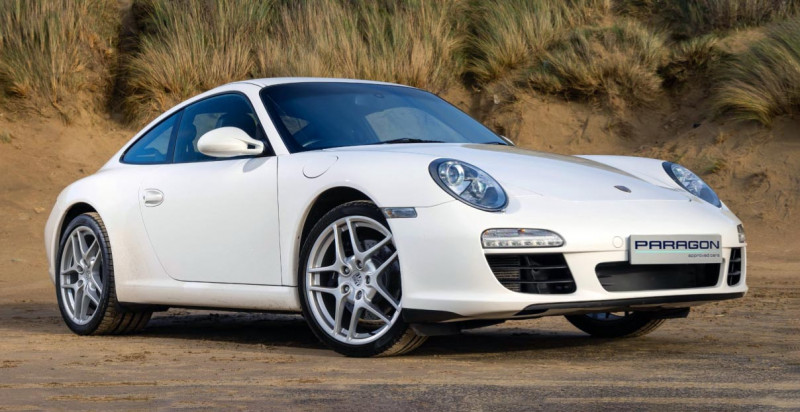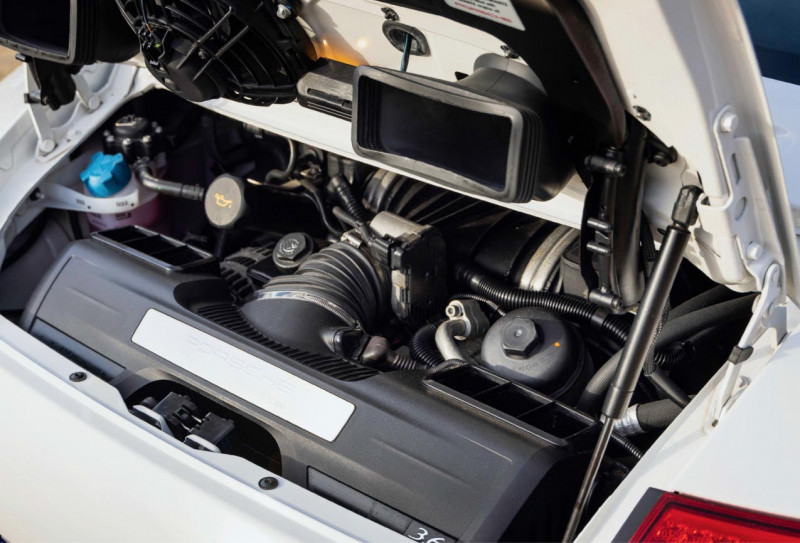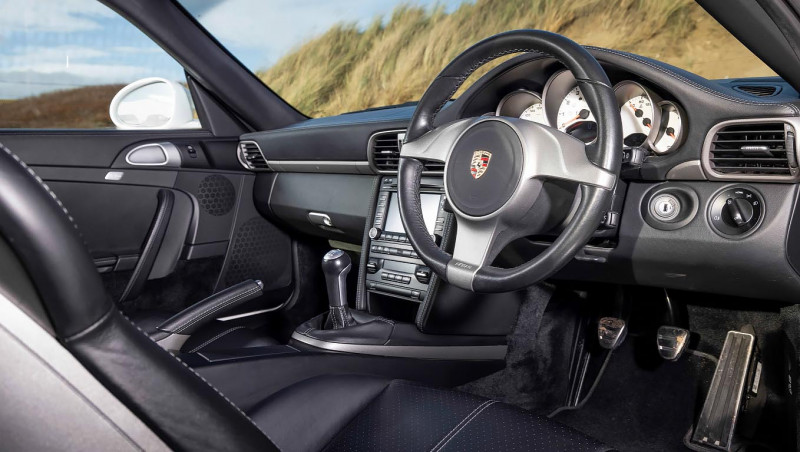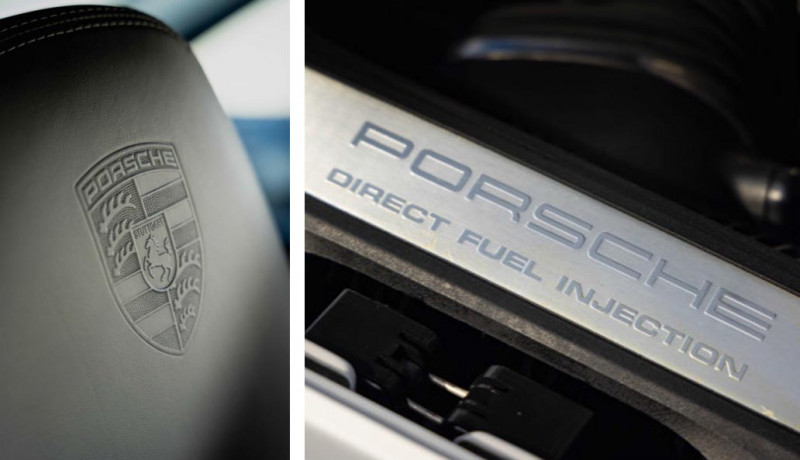2010 Porsche 911 Carrera 997.2
Already a modern classic, the 997.2 Carrera is a great link between old and new, as Total 911 discovers on a winter drive…
Written by Tim Pitt
Photography by Daniel Pullen
997.2 CARRERA: THE PIVOTAL PORSCHE
Why the Gen2 997 is the best blend of old and new 911s
Tim Pitt road tests the base 997 Gen2 and explores why it could be the perfect blend of old and new 911
BACK TO BASICS
The molten orange sun hangs low in the winter sky, casting long shadows that will soon stretch into darkness. Photographers call this time between daytime and dusk the Golden Hour, but snapper Dan Pullen already has today’s shoot in the bag. For me, that means no more standing around shivering while I hold the wireless flash, and no more back-and-forth panning shots punctuated by five-point turns. All I need to think about now is the car and the road.

Accelerating hard in second gear, the naturally aspirated flat six gulps down lungfuls of dense January air, its tone hardening to a fierce metallic snarl. I snick-snick the lever across into third as we crest a hill, then plunge downwards into a tunnel of trees. Shards of sunlight cut through the branches to my left, fast and intense, creating a flickering effect like a vintage Super 8 film. It’s both dazzling and a little bit disorientating.
“In a world of charmless crossovers and anaesthetised EVs, this basic 997.2 Carrera is the perfect palate cleanser”
My brain might be crackling with static, but the 911 communicates with fibre-optic clarity. It feels alive to every input: hard-wired into my fingertips, the balls of my feet and the seat of my pants. In a world of charmless crossovers and anaesthetised EVs, this basic 997.2 Carrera is the perfect palate cleanser. As the sun finally slips behind the horizon, I just want to keep driving it.

Rewind seven hours to a crisp, cold morning in East Sussex. The creamy Carrera white 997 is parked up outside Paragon Porsche, next to a Shark blue 992 GT3. The contrast between these two 911s could hardly be greater: one unadorned and understated, the other bristling with aggressive aero. The 997’s lofty ride height on 19-inch Carrera S wheels doesn’t help its cause (a sports suspension kit that lowered the car by 20mm was optional), but its round headlights and classic curves haven’t dated a day. Only the glittery LED tail lamps – introduced for the Gen2 update in 2008 – look obviously of their era. The narrow body 997 is also 138mm shorter and 44mm slimmer across the haunches than the modern GT3. Seeing the two Porsches side by side, it almost appears to have shrunk in the wash. It’s hardly an innovative observation, I know, but when did cars become so big?

Paragon MD Mark Sumpter clearly likes the less-is- more ethos of this particular Carrera. “I think it was probably bought on a budget,” he opines. “It’s a 2010 car, originally sold soon after the financial crash. A few years ago, the relative lack of optional extras would have counted against it. Now, strangely, that simplicity makes it even more appealing.”
For the record, the options fitted here include bi-xenon headlights, sat-nav, heated sports seats, rear parking sensors, cruise control, Bluetooth phone connectivity, silver dials and a USB socket – so it’s hardly a bare-bones example. However, in the spirit of simplicity, the first owner chose a six-speed manual transmission rather than the seven-speed PDK. And this option, more than any other, is what defines the car’s character.
Not that I’m PDK-bashing, you understand. Launched in 2008, the 997.2 was the first iteration of 911 with the game-changing twin-clutch gearbox, which replaced the slower and less-intuitive Tiptronic. Then, as now, PDK effectively offered the best of both worlds: smooth automatic shifting in town, then razor-sharp response via the paddles on the open road – particularly when teamed with the Sport Chrono pack. It quickly gained popularity with 911 buyers, making a late-model 997 with a manual ’box quite unusual, says Mark.
The other major mechanical change for the 997.2 was the introduction of chain-driven, dry-sumped MA1 DFI engines. In the Carrera, this means a useful boost in power and torque: now 345hp and 390Nm, up from 325hp and 370Nm in the 997.1. Even without all-wheel traction, the sprint to 62mph takes a scant 4.9 seconds. That’s half a second quicker than a 964 Turbo and snapping at the tailpipes of a 996.1 GT3. Top speed is 179mph.

Injecting fuel directly at up to 120 bar also results in better economy and lower CO2 emissions. The official figures are 29mpg and 225g/km, but Paragon sales manager Jamie Tyler says you can achieve “low 30s mpg if you take it steady, while the Gen1 cars managed high 20s at a push”. Importantly, DFI engines also meet the Euro 5 emissions standard – vital if you want to drive your 911 in central London without paying the £12.50-a-day ULEZ charge (which expands to most areas within the M25 from August 2023). Longer service intervals – every two years or 20,000 miles – potentially make the 997.2 more affordable to run, too.
The final benefit of the new engines is improved reliability. The previous M96/M97 family, fitted to the 996 and 997.1, was prone to problems with bore scoring and intermediate shaft bearing failure. This was less common in Gen1 997s (particularly post- 2006 cars with their larger bearings), and many have since had remedial work carried out. Nonetheless, it’s a potentially serious issue that the 997.2 buyer doesn’t need to worry about.

Without the bulky, cocooning centre console of newer 911s, the compact 997 feels spacious inside. The big-bolstered sports seats fitted here are comfortable, too. This version of Porsche Communication Management (PCM) does boast a – then unusual, now ubiquitous – touchscreen, but other mod-cons, from cupholders to electronic driver aids, are notable by their absence. “People come to these cars from modern Audis or BMWs and expect the headlights and wipers to switch on automatically,” jokes Jamie. “Here, you have to do things yourself.” As I’ll discover, that’s equally true for the driving experience. Jamie calls the 997.2 “the last of the analogue-feeling 911s”, citing its hydraulic power steering (the post-2011 991 switched to a fuel-saving electric system) and lack of configurable drive modes. Rear-wheel steering wasn’t an option, either. But while there are fewer menus and modes to navigate, this 911 keeps you busy in other ways.

We’re heading south-east from Five Ashes towards Dungeness on the Kent coast, through quaint villages connected by fast-flowing A-roads and narrow capillary lanes. The tarmac is cold and still strewn with puddles, so I set my heated seat to scorchio and leave Porsche Stability Management (PSM) very much switched on. With just 20,000 miles on the clock – and the benefit of Paragon’s expert preparation – the 997 immediately feels tight and wonderfully together. Even after the first, rather tentative couple of corners, I’m in no doubt this is a proper driver’s car.
A manual gearbox feels like a rare treat in 2023, and the 997’s six-speeder really is one of the best. The clutch is light and positive, while the stubby lever feels spring-loaded, slotting across the ’box with well-oiled precision. A greater contrast to the spindly wand and ‘soup stirrer’ action of the classic 915 manual transmission in early 911s is hard to imagine. The top-hinged pedals are nicely spaced for heel-and-toe downshifts, too.
Talking of contrasts, the last 911 I drove, in late 2022, was a new 992 GT3 RS, which has a race car-style steering wheel festooned with 12 buttons and four rotary controllers. The 997.2’s naked, three-spoke wheel is quite the opposite. Its sole purpose is to steer the car, and that single-minded clarity is reflected in how it responds. It feels alert and direct, yet calm enough to cut through white noise, delivering a steady stream of glorious, confidence-inspiring feedback.
Successive winters and council budgets haven’t been kind to the Sussex lanes, which are scarred by blisters and open wounds. The Porsche doesn’t sugar-coat things, its suspension relaying every ripple in the road, but it hardly ever crashes or thumps. Even at lower speeds, the measured quality of its damping shines through. The standard 18-inch Carrera wheels, rather than the optional 19s fitted here, would probably be better still.
I quickly give up on the 911s blocky, 2010-spec sat-nav and resort to Google Maps. Having a USB socket to charge my phone is certainly a bonus in a 13-year-old car, though – you won’t find that in a 997.1. As we pause for a coffee near Bodiam Castle, Dan scouts for photo locations and I take a moment to prod and poke the 911’s various switches. Its dashboard feels so much more substantial than a 996 – and vastly more up-to-date than any air-cooled car. Fuelled by caffeine and super unleaded, it’s time to stretch the 911’s legs. The 3.6-litre engine pulls strongly from low speeds, even though maximum torque doesn’t arrive until 4,400rpm (compared to 1,900rpm in a new 992 Carrera). Throttle response is sharp and wonderfully linear, the traditional 911 central tacho whipping around to its 7,400rpm redline with real urgency. On the road, I think you’d rarely want for more.
Direct fuel injection does muffle the 911’s soundtrack a little, particularly in a car without a sports exhaust, as here. However, the visceral induction roar and high-rev howl are unmistakably those of a Stuttgart flat six. And the muted tones lower down suit the Carrera’s role as a daily driver 911 – not merely a weekend plaything.
We pause for more photos by the beach at Camber Sands, then snake along a series of open, well-sighted roads into Kent. With freshly moulded Pirelli P Zero rubber on a now-dry surface, the 997 proves sure-footed and almost impossible to unstick. Only if you really provoke it will the back end start to drift wide. Brilliant body control and a neutral sense of balance make this 911 easy to exploit – and less intimidating than a Turbo or GT3.
Don’t mistake the Carrera for a soft option, though. This isn’t a car you can drive on autopilot, and nor would you want to. The point about being ‘analogue’ is slightly subjective, but the 997.2 feels like a different machine to the 991 that followed: more sports car and less super-GT. Progress moves in mysterious ways.
For me, the only chinks in the 997’s armour are its brakes – 318mm front and 299mm rear discs – which feel slightly soft, particularly around the top of the pedal travel. They’re fine once you tune into them, but newer 911s certainly have more stopping power. PCCB carbon-ceramics were an expensive option on the 997.2, incidentally, and few buyers went for them. Still, I’m clutching at straws a little, because the 997.2 feels like a near-perfect blend between classic tactility and modern civility (not to mention reliability). This 2010 car is for sale at £51,995, which Jamie says is £15,000 or so more than a 2007 997.1 in the same condition with similar mileage. Consider that, at the time of writing, Paragon also has a 2011 997 GTS in stock for £84,995, however, and the Carrera suddenly starts to look good value. Put simply, look after them and you shouldn’t lose money on any of these cars.
It’s fully dark by the time we get back. Spattered with mud and smeared with road grime, the Porsche looks even cooler than when I collected it. It might ‘only’ be a Carrera, but we’ve made some memories today – and that’s what the best cars are all about. After a quick browse around the Paragon showroom (highlights: a 964 Carrera RS, 996 GT2, 997 GT2 RS and Carrera GT), I reluctantly return the keys.
I drive home to London in a new Volkswagen Golf R, which I have on loan for a week. In many ways it’s the consummate modern performance car, with slingshot four-wheel-drive traction, a rapid-fire DSG dual-clutch gearbox and mighty slugs of turbocharged torque. It’s very nearly as powerful as the Porsche and undoubtedly quicker from point-to-point on greasy roads. Yet for all its speed and ability, the mega-Golf doesn’t energise the senses and stir the soul like a 997.2 Carrera. Very few cars do.
THANKS The car in our pictures was supplied by Paragon Porsche. For more information on this exquisite example visit paragongb.com or call +44 (0) 1825 830 424.
TECHNICAL DATA
- Model 911 997.2 Carrera
- Year 2010
Engine
- Capacity 3,614cc
- Compression ratio 12.5:1
- Maximum power 345hp @ 6,500rpm
- Maximum torque 390Nm @ 4,400rpm
- Transmission Six-speed manual
Suspension
- Front MacPherson struts, coil springs, anti-roll bar
- Rear Multi-link, coil springs, anti-roll bar
Wheels & tyres
- Front 8x18-inch; 235/40/ZR18
- Rear 10.5x18-inch; 265/40/ZR18
Dimensions
- Length 4,435mm
- Width 1,808mm
- Weight 1,415kg
Performance
- 0-62mph 4.9 seconds
- Top speed 179mph
LEFT The 997.2 was first to introduce Porsche’s PDK twin-clutch gearbox, which replaced the slower, lessintuitive Tiptronic automatic
ABOVE The 997.2 Carrera era was the first to use direct fuel injection (DFI) on its flat six, the technology of which Porsche still uses today across the 911 range


